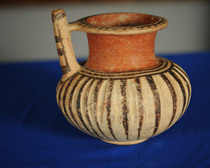Archived Content
In an effort to keep ICE.gov current, the archive contains content from a previous administration or is otherwise outdated. This information is archived and not reflective of current practice.
ICE and CBP officials return pre-Columbian artifacts to Panama
WASHINGTON - Today at U.S. Immigration and Customs Enforcement (ICE) headquarters, ICE Director John Morton and U.S. Customs and Border Protection (CBP) Assistant Commissioner Thomas S. Winkowski repatriated 99 pre-Columbian artifacts seized as a result of operations by ICE's Homeland Security Investigations (HSI) and CBP in Los Angeles and Portland, Ore., to Panamanian President Ricardo Martinelli.
"Sadly, the theft and trafficking of cultural artifacts is one of the oldest forms of organized cross-border crime," said ICE Director Morton. "While seizing, forfeiting and repatriating cultural artifacts like these is indeed reason for celebration, our long-term goal is to reduce the incentive for further destruction of ancient tombs and temples, where so many of these objects are dug up or chiseled off and pilfered."
"The joint efforts to identify and return such important Panamanian artifacts exemplify the outstanding level of cooperation and partnership between the Panama and the United States to fight different types of international crime and specifically to protect our historical patrimony and culture," said President Martinelli. "We remain committed to working closely with the United States to any necessary undertake measures to preserve our cultural heritage, and it is my sincere hope that efforts such as these will lead to the end the trafficking of illegal antiquities around the world."
"Customs and Border Protection is pleased to have partnered with ICE and the U.S. Attorney to help return these priceless artifacts to their lawful owner," said CBP Assistant Commissioner Winkowski. "Thanks to the dedication of the men and women of CBP, these artifacts will provide the people of Panama a key to their past."
These items, previously imported into the United States, were discovered as part of an investigation that began in 1998, under the U.S. Customs Service, an ICE legacy agency. The ICE attaché office in Panama received a tip from Panamanian investigators that a Panama Canal Commission employee was smuggling pre-Columbian artifacts out of Panama into the United States. Panamanian authorities advised that the individual exported four large shipping containers, manifested as household goods, to Oregon - containers that they believed contained pre-Columbian artifacts. A search of the containers revealed six Panamanian pre-Columbian artifacts, among other items. The artifacts were seized and returned to Panama.
Later that year, Panamanian investigators executed a search warrant at the employee's residence in Panama, during which 148 pre-Columbian artifacts were recovered. The employee was indicted in 2003 in Oregon for smuggling and conspiracy to transport, receive, possess, conceal and store stolen property. The individual pleaded guilty to smuggling and was sentenced to probation.
Two other individuals were also identified as part of the employee's conspiracy. ICE HSI agents intercepted shipments of pre-Columbian artifacts destined for the United States addressed to one of those individuals, a professor at a U.S. university. Both individuals were indicted for conspiracy to transport, receive, possess, conceal and store stolen property though the charges were ultimately dismissed. The professor agreed to turn over 99 Panamanian pre-Columbian artifacts that he illegally imported into the United States from Panama as part of the plea agreement. In 2005, ICE HSI agents in Los Angeles and Portland supervised the authentication, inventory and seizure of the 99 artifacts.
Valued at approximately $100,000, these artifacts represent a very complete sample of most of the pottery styles in pre-Columbian Panama from the period A.D. 1 through 1500. These are unique artifacts, made entirely by hand by Native American Indian potters, without use of a throwing wheel or mass production techniques. During this period in Panama, potters were considered specialists in their craft and presumably at the service of chiefs.
The confiscated materials were likely looted from graves in south-western Veraguas around the shores of the Gulf of Montijo. The repatriated items include three-legged grinding tables known as "metates" used for grinding maize kernels, pottery vessels and figurines, and pedestal plates.
ICE HSI plays a leading role in investigating crimes involving the illicit importation and distribution of cultural property. ICE HSI uses its investigative authority to seize cultural property items if they were illegally imported into the United States. It also investigates the illegal trafficking of artwork, especially works that have been reported lost or stolen. ICE's Office of International Affairs, through its 69 attaché offices in 47 countries, works closely with foreign governments to conduct joint investigations, when possible.
ICE HSI agents undergo special training sessions funded by the State Department and held at the Smithsonian museums and research facilities before they begin working cultural property cases. Smithsonian staff provided behind-the-scenes introduction to objects from regions that are at greatest risk of looting and trafficking, as well as practical skills training in handling, photographing, recording and packing objects.
More than 2,300 artifacts have been returned to 18 countries since 2007 including paintings from France, Germany and Austria, an 18th century manuscript from Italy, and a bookmark belonging to Hitler as well as cultural artifacts from Iraq including Babylonian, Sumerian, and neo-Assyrian items.
Agencies involved in the seizure and investigation of the items being repatriated today include ICE HSI and CBP in Los Angeles and Portland, Ore.
CBP is the nation's lead border security agency and is charged with enforcing hundreds of laws at and between our nation's 327 international ports of entry. As part of that mission, CBP enforces bi-lateral agreements and import restrictions on certain foreign cultural property and archaeological materials. CBP works closely with ICE and other federal, state and local law enforcement agencies to prevent the illegal trade and trafficking of cultural antiquities. CBP partners with ICE to ensure that illegally traded and trafficked antiquities are returned to their rightful owners.










